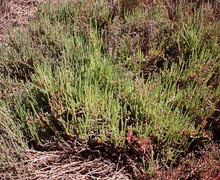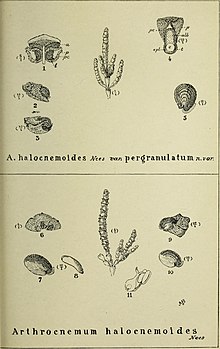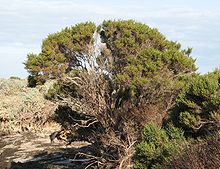Tecticornia
| Tecticornia | |
|---|---|

| |
| Samphire, Tecticornia pergranulata | |
| Scientific classification | |
| Kingdom: | Plantae |
| Clade: | Tracheophytes |
| Clade: | Angiosperms |
| Clade: | Eudicots |
| Order: | Caryophyllales |
| Family: | Amaranthaceae |
| Subfamily: | Salicornioideae |
| Genus: | Tecticornia Hook. f. |
| Species | |
|
ca. 44 species, see text | |
Tecticornia is a genus of succulent, salt tolerant plants largely endemic to Australia. Taxa in the genus are commonly referred to as samphires.[1] In 2007, the genus Halosarcia, along with three other Australian genera (Pachycornia, Sclerostegia and Tegicornia) was incorporated into the genus.
Description[]



The species of Tecticornia grow as annual or perennial herbs, subshrubs or small shrubs. Stems are branched, glabrous and appear jointed. The opposite leaves are fleshy, glabrous, connate in the lower part and cup-like or collar-like stem-clasping, with minute (0–3 mm long) two-lobed to triangular leaf blades.[2]
The spike-shaped inflorescences consist of opposite bracts, mostly connate and stem-clasping, free in some species. Their blades are cup- or collar-like or deltoid to semi-circular scales. In the axil of each bract, there are three to five (rarely one or seven) flowers, free or sometimes fused to each other, to the bract, and to the inflorescence axis. The flowers are hermaphrodite, rarely unisexual. They consist of a 2-3-lobed perianth of connate tepals, one stamen, and an ovary with two stigmas.[2]
In fruit, the perianth remains membranous or becomes crustaceous, spongy, or horny. The fruit wall (pericarp) may be membranous, fleshy, crustaceous, or woody. The seed is disc-shaped or wedge-shaped, its seed coat with smooth or reticulate, tuberculate or longitudinally ribbed surface. The seed contains the curved embryo and copious perisperm (feeding tissue).[2]
Distribution[]
All species of Tecticornia are distributed in Australia. Only one species, Tecticornia indica (Syn. Halosarcia indica, Arthrocnenum indicum) has a wider range outside this continent along the tropical coasts of the Indian Ocean to eastern and western tropical Africa.[2]
Systematics[]
The first publication of Tecticornia was made in 1880 by Joseph Dalton Hooker.[3] The type species of this genus is Tecticornia cinerea (F. Muell.) Baill,[4] which is a synonym of Tecticornia australasica. Tecticornia used to be a small genus with just three species, until in 2007, the genera Halosarcia, Pachycornia, Sclerostegia and Tegicornia were included.[5]
Phylogenetical research of the subfamily Salicornioideae revealed that the Tecticornia/Halosarcia/Pachycornia/Sclerostegia/Tegicornia lineage is a sister group of Sarcocornia/Salicornia.[2]
In 2016, Tecticornia comprises about 44 species,[6] eleven species were described recently.[7][8][9][10][11][12] (distributions as given by Australian Plant Census (2008).[6]
- K.A.Sheph. & M. Lyons - in Western Australia.[11]
- Paul G.Wilson (Bulli Bulli) - in Western Australia.
- Tecticornia arbuscula (R.Br.) K.A.Sheph. & Paul G.Wilson, (Shrubby Glasswort) - widely distributed in Australia (Western Australia, South Australia, New South Wales, Victoria, Tasmania).
- (Paul G.Wilson) K.A.Sheph. & Paul G.Wilson - in Western Australia.
- Tecticornia australasica (Moq.) Paul G.Wilson - in Northern Territory, Queensland.
- Tecticornia bibenda K.A.Sheph. & S.J.van Leeuwen - in Western Australia.[7]
- (Paul G.Wilson) K.A.Sheph. & PaulG.Wilson, (Large-articled Samphire) - Inland growing plant found in Western Australia and listed as being vulnerable to extinction.[13]
- Tecticornia calyptrata (Paul G.Wilson) K.A.Sheph. & Paul G.Wilson - a divaricately branched shrub ranging to 1 metre in height. Found across Western Australia in both sandy and clay soils, salt lakes, and saline claypans.[14]
- (Paul G.Wilson) K.A.Sheph. & Paul G.Wilson - in Western Australia.
- (Paul G.Wilson) K.A.Sheph. & Paul G.Wilson - in South Australia, Queensland
- K.A.Sheph. & Paul G.Wilson - in Western Australia.[8]
- (Paul G.Wilson) K.A.Sheph. & Paul G.Wilson - Western Australia, Northern Territory, New South Wales, Tasmania.
- (Paul G.Wilson) K.A.Sheph. & Paul G.Wilson - in Western Australia.
- (Paul G.Wilson) K.A.Sheph. & Paul G.Wilson - in Western Australia.
- (Paul G.Wilson) K.A.Sheph. & Paul G.Wilson - in Western Australia.
- (Paul G.Wilson) K.A.Sheph. & Paul G.Wilson, (Bead Samphire or Bead Glasswort) - a woody, perennial, salt-tolerant plant growing up to 20 centimetres high in saltmarshes associated with salt lakes and saline flats and usually in monospecific patches. It is a deciduous shrub with fleshy branches, flowering and fruiting from January to May. T. flabelliformis is found in South Australia, Victoria and Western Australia with most of the population in South Australia. It is nationally listed as being vulnerable to extinction,[15] with state by state listings as vulnerable in South Australia, threatened in Victoria and poorly known in Western Australia.[16] (Eyelash Samphire)
- (Paul G.Wilson) K.A.Sheph. & Paul G.Wilson - in South Australia.
- K.A.Sheph. - in Western Australia.[12]
- Tecticornia halocnemoides (Nees) K.A.Sheph. & Paul G.Wilson, (Shrubby Samphire or Grey Glasswort) - widely distributed in Australia (Western Australia, Northern Territory, South Australia, Queensland, New South Wales, Victoria).
- K.A.Sheph. - in Western Australia.[9]
- Tecticornia indica (Willd.) K.A.Sheph. & Paul G.Wilson - has several subspecies. Widely distributed in Australia (WA, NT, SA, Qld, NSW, Vic) and along tropical coasts of Indian Ocean from Southeast asia to South Asia, East Africa, Madagascar, southeastern Africa, and Atlantic coast of Senegal.[2]
- K.A.Sheph. - in Western Australia.[8]
- (Paul G.Wilson) K.A.Sheph. & Paul G.Wilson - in Western Australia, South Australia.
- (Paul G.Wilson) K.A.Sheph. & Paul G.Wilson - in Western Australia.
- K.A.Sheph. & M. Lyons - in Western Australia.[11]
- (Ewart & Jean White) K.A.Sheph. & Paul G.Wilson - in Western Australia, South Australia, New South Wales?, Victoria
- (Paul G.Wilson) K.A.Sheph. & Paul G.Wilson - in South Australia, Queensland, New South Wales.
- K.A.Sheph. - in Western Australia.[12]
- K.A.Sheph. - in Western Australia.[8]
- (Paul G.Wilson) K.A.Sheph. & Paul G.Wilson - in Western Australia, Victoria.
- (Paul G.Wilson) K.A.Sheph. & Paul G.Wilson - in South Australia, Victoria
- K.A.Sheph. - in Western Australia.[10]
- (Paul G.Wilson) K.A.Sheph. & Paul G.Wilson - in Western Australia.
- Tecticornia pergranulata (J.M.Black) K.A.Sheph. & Paul G.Wilson, (Samphire, Blackseed Glasswort or Blackseed Samphire) - found inland across much of Australia and, less often, in coastal saline areas.
- (Paul G. Wilson) K.A.Sheph. & Paul G.Wilson - in South Australia, New South Wales
- (Paulsen) K.A.Sheph. & Paul G.Wilson - in Western Australia, Northern Territory, South Australia, New South Wales, Victoria.
- (J.M.Black) K.A.Sheph. & Paul G.Wilson - in Western Australia, South Australia, New South Wales, Victoria
- K.A.Sheph. & M. Lyons - in Western Australia.[11]
- (Paul G.Wilson) K.A.Sheph. & Paul G.Wilson - in Western Australia, South Australia, Victoria.
- (Benth.) K.A.Sheph. & Paul G.Wilson - in Western Australia, Northern Territory, South Australia, Queensland, New South Wales, Victoria.
- (F.Muell.) K.A.Sheph. & Paul G.Wilson - in Western Australia, Northern Territory, South Australia, Queensland, New South Wales, Victoria.
- (Paul G.Wilson) K.A.Sheph. & Paul G.Wilson - in Western Australia, Northern Territory, South Australia.
- (Paul G.Wilson) K.A.Sheph. & Paul G.Wilson, (Mat Samphire) - dioecious, with only one flower at each bract,[2] - in Western Australia.
- Paul G.Wilson - in Western Australia, Northern Territory, South Australia.
Uses[]
Young twigs of Tecticornia indica can be cooked and eaten as a vegetable. In Madagascar, they are pickled in vinegar and used as a spice.[17]
References[]
- ^ "Tecticornia". FloraBase. Western Australian Government Department of Parks and Wildlife.
- ^ Jump up to: a b c d e f g Kadereit, G.; Mucina, L.; Freitag, H. (2006). "Phylogeny of Salicornioideae (Chenopodiaceae): diversification, biogeography, and evolutionary trends in leaf and flower morphology". Taxon. 55 (3): 617–642. doi:10.2307/25065639. JSTOR 25065639..
- ^ Joseph Dalton Hooker (1880). "Genera Plantarum ad exemplaria imprimis in herbariis Kewensibus", 3(1), p. 65. first description of Tecticornia
- ^ "Tecticornia". Tropicos. Missouri Botanical Garden. Retrieved 15 August 2016.
- ^ Shepherd, K.A.; Wilson, P.G. (2007). "Incorporation of the Australian genera Halosarcia, Pachycornia, Sclerostegia and Tegicornia into Tecticornia (Salicornioideae, Chenopodiaceae)". Australian Systematic Botany. 20 (4): 319–331. doi:10.1071/sb07002.
- ^ Jump up to: a b APC - Australian Plant Census (2008). Tecticornia, CHAH.
- ^ Jump up to: a b Shepherd, K.A.; Leeuwen, S.J. (2007). "Tecticornia bibenda (Chenopodiaceae: Salicornioideae), a new C4 samphire from the Little Sandy Desert, Western Australia". Nuytsia. 16 (2): 388–390.
- ^ Jump up to: a b c d Shepherd, K.A. (2007). "Three new species of Tecticornia (formerly Halosarcia) (Chenopodiaceae: Salicornioideae) from the Eremaean Botanical Province, Western Australia". Nuytsia. 17 (1): 353–366.
- ^ Jump up to: a b Shepherd, K.A. (2007). "Tecticornia indefessa (Chenopodiaceae: Salicornioideae), a new mat samphire (formerly Tegicornia) from north of Esperance, Western Australia". Nuytsia. 17: 367–374.
- ^ Jump up to: a b Shepherd, K.A. (2008). "Tecticornia papillata (Chenopodiaceae: Salicornioideae), a new andromonoecious samphire from near the Carnarvon Range, Western Australia". Nuytsia. 18: 261–264.
- ^ Jump up to: a b c d Shepherd, K.A.; Lyons, M.N. (2009). "Three new species of Tecticornia (Chenopodiaceae, subfamily Salicornioideae) identified through Salinity Action Plan surveys of the central wheatbelt region, Western Australia". Nuytsia. 19: 167–180.
- ^ Jump up to: a b c Shepherd, K.A. (2011). "Tecticornia globulifera and T. medusa (subfamily Salicornioideae: Chenopodiaceae), two new priority samphires from the Fortescue Marsh in the Pilbara region of Western Australia". Telopea. 13 (1–2): 351–355. doi:10.7751/telopea20116026.
- ^ "Species Profile and Threats Database, Halosarcia bulbosa". Australian Government, Department for Environment and Heritage. Retrieved 2006-10-02.
- ^ "Halosarcia calyptrata". Florabase. Retrieved 2006-10-18.
- ^ "Threatened Flora of Eyre Peninsula" (PDF). Australian Government, Department for Environment and Heritage. Archived from the original (PDF) on 2006-09-20. Retrieved 2006-10-01.
- ^ Department of the environment, Australia (2004). "EPBC Nomination to de-list from the Vulnerable category, Halosarcia flabelliformis (Bead Glasswort)" (PDF). Retrieved 2007-02-07.[permanent dead link]
- ^ Halosarcia indica at PROTA4U Archived 2016-08-01 at the Wayback Machine
External links[]
 Media related to Tecticornia at Wikimedia Commons
Media related to Tecticornia at Wikimedia Commons Data related to Tecticornia at Wikispecies
Data related to Tecticornia at Wikispecies
- Amaranthaceae genera
- Amaranthaceae
- Caryophyllales of Australia
- Halophytes
